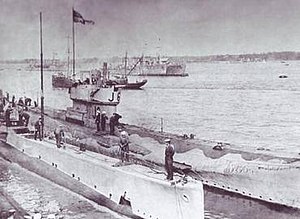HMS J6 was a First World War J-class submarine built for the Royal Navy by HM Dockyard at Devonport in Plymouth.[1] Commissioned in 1916, she was sunk in a friendly fire incident by the Q-ship Cymric in October 1918.
 RN submarine HMS J6
| |
| History | |
|---|---|
| Name | HMS J6 |
| Builder | HM Dockyard, Devonport |
| Laid down | 26 April 1915 |
| Launched | 9 September 1915 |
| Commissioned | 25 January 1916 |
| Fate | Sunk 15 October 1918 |
| General characteristics | |
| Class and type | J-class submarine |
Career
editUnder her first commanding officer, Max Horton, J6 was launched on 9 September 1915 and commissioned on 25 January 1916. She and the other Js were members of the 11th Submarine Flotilla. She served in the North Sea chiefly in operations against German destroyers and U-boats. The closest she got to sinking the enemy was firing a torpedo at U-61, but it missed its target.
On 1 December 1917 Horton was replaced as commanding officer of J6 by Lieutenant Commander Geoffrey Warburton. In April 1918, Warburton spotted the German High Seas Fleet, which had put to sea in an attempt to hunt down an Allied convoy. Warburton did not identify the fleet as German and did not report his sighting to the Admiralty; had he done so, it is possible that another full scale naval battle may have occurred.[2]
Loss
editOn 15 October 1918 J6 was on patrol off the Northumberland coast when she was spotted by the Q-ship Cymric. The captain of the Cymric, Lieutenant F Peterson RNR, mistook the identity lettering on the conning tower of J6 for U6. Assuming U6 to indicate a German U-boat, Peterson raised the White ensign and opened fire on J6.[3] J6 tried to signal, but the signalman was killed. J6 fled into a fog bank, but Cymric located J6 again and sank her.[4] After a number of direct hits, J6 sank. It was only after the survivors were seen in the water that Peterson and the crew of Cymric realised their mistake and recovered the survivors. Of the crew of J6, 15 were lost;[5] a subsequent court of enquiry found that no action would be taken against Peterson.[6] An order under the Official Secrets Act prohibited mention of this incident until 1969.[7]
Late in 2011 it was announced that divers had discovered her wreck off Seahouses.[8] In the summer of 2013, the Polish Navy salvage ship ORP Lech, searching for the wreck of the Polish submarine ORP Orzeł, surveyed and officially confirmed the identity of J6.[9]
References
edit- ^ Colledge, J. J.; Warlow, Ben (2010) [1969]. Ships of the Royal Navy: The Complete Record of All Fighting Ships of the Royal Navy (4th Rev ed.). Newbury, Berkshire: Casemate. p. 200. ISBN 978-1-935149-07-1. OCLC 603386630.
- ^ G Staff (June 1983). "The J Class Submarines". Naval Historical Review. Naval Historical Society of Australia. Retrieved 26 December 2011.
- ^ Court of Enquiry into sinking of HM Submarine J.6 by HM Special Service Vessel CYMRIC. Lieut F.H. Peterson D.S.O., D.S.C., R.N. HMS CYMRIC (Report). The Admiralty. 1918. The National Archives ADM 156/131.
- ^ Akermann 1989, p. 162
- ^ Akermann reports 14 lost. Akermann 1989, p. 162
- ^ Court of Enquiry into sinking of HM Submarine J.6 by HM Special Service Vessel CYMRIC. Conduct of Lieut F.H. Petersen D.S.O., D.S.C., R.N. HMS CYMRIC (Report). The Admiralty. 1919. The National Archives ADM 156/147.
- ^ Richie, Carson (1985). Q-ships. Terence Dalton. p. xi. ISBN 0-86138-011-8.
- ^ Fletcher, Richard (4 December 2011). "Divers find WWI submarine wreck off Seahouses coast". Sunday Sun. Newcastle. Retrieved 10 January 2012.
- ^ Zalesiński, Łukasz (18 October 2013). "Polacy odkryli brytyjski okręt [The Poles discovered a British ship]". Polska Zbrojna (in Polish). Retrieved 5 February 2014.
Bibliography
edit- Akermann, Paul (1989). Encyclopedia of British Submarines 1901-1955. Periscope Publishing Ltd. ISBN 978-1-904381-05-1.